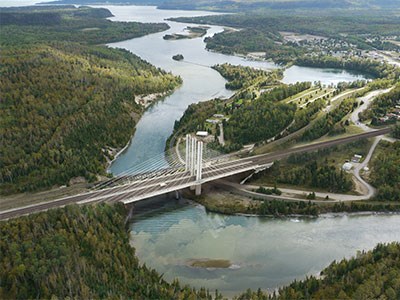Motor vehicle traffic across the Nipigon River Bridge was reduced to one lane Jan. 11 after the newly constructed span split, causing a backlog of traffic on the Trans-Canada Highway.
The 252-metre bridge was closed by the Ontario Provincial Police on Jan. 10 as engineers spent the night assessing the extent of the damage.
A Thunder Bay media outlet reported bolts holding a girder to a bearing on an expansion joint broke on the north side of the bridge causing the eastern section of the bridge to rise about two feet.
The bridge is situated at a critical point in Canada’s highway network as there are no detours, causing commercial and private vehicle traffic to back up on both sides.
The $106-million bridge opened to traffic in late November as demolition of the old bridge took place over the fall.
It was called the province’s “crown jewel” by Northern Development and Mines Minister Michael Gravelle in the government’s ongoing four-laning of Highway 11-17 between Thunder Bay and Nipigon.
The cable-stayed bridge — the first such bridge in Ontario — uses towers to hold up the bridge deck with a series of cables, similar to a suspension bridge.
Transport Minister Steven Del Duca said in a statement: “I have spoken with Minister Michael Gravelle and (Nipigon) Mayor Richard Harvey and assured them that MTO (Ministry of Transportation) will do everything they can do to restore the bridge quickly, while also making sure that the safety of the travelling public remains of paramount importance. I will also speak to Minister Gravelle following his visit to the site. As the local MPP for this community, he has demonstrated tremendous leadership during this challenging time.”
The project is a joint venture between Ontario’s Bot Construction and international construction company Ferrovial Agroman (Bot Ferrovial Nipigon Joint Venture), with the Ministry of Transportation as the project owner. The bridge uses three towers to hold up the deck with a series of cables similar to a suspension bridge.




